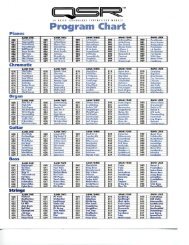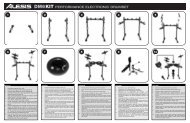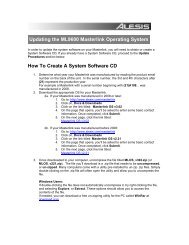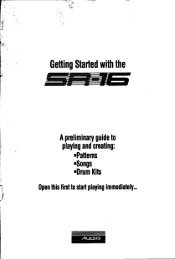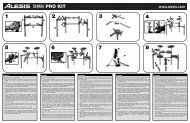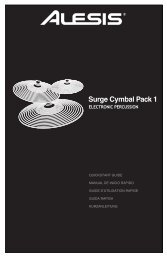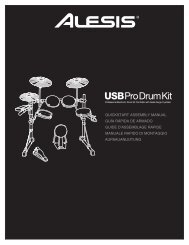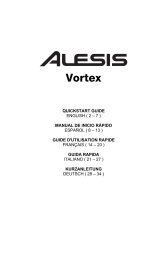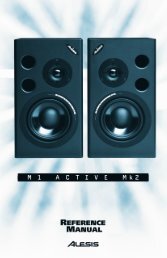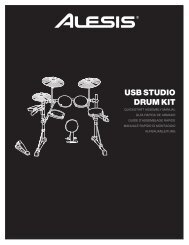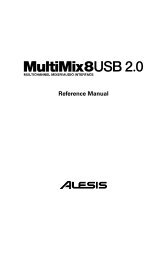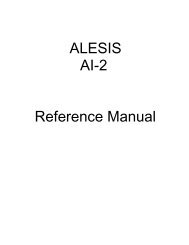QSR Reference Manual - Alesis
QSR Reference Manual - Alesis
QSR Reference Manual - Alesis
- No tags were found...
Create successful ePaper yourself
Turn your PDF publications into a flip-book with our unique Google optimized e-Paper software.
Editing Programs: Chapter 6Level (00 to 99) Page 5This is the base output level of the Amp LFO. If you want to have a constant value oftremolo, even without using the Mod Wheel or Aftertouch, set Level above 00. TheMod Wheel and Aftertouch will add or subtract from this base level. Example: IfLevel is set to 10 and the Mod Wheel parameter is set to 10, there will always besome tremolo, and raising the Mod Wheel will add more tremolo. On the other hand,if the Mod Wheel parameter is set to -10, raising the Mod Wheel to the top will cancelout all tremolo.Mod Wheel Depth (-99 to 99) Page 6This is the modulation amount of the Mod Wheel over the Amp LFO’s Level. Apositive value raises the level when the Mod Wheel is moved up, and lowers thelevel when moved down. Negative settings of this parameter will decrease theoutput level of the Amp LFO as the Mod Wheel is raised. Since the output level ofthe Amp LFO cannot be less than zero. A negative setting of the Mod Wheelparameter will have no effect unless either the Aftertouch or the Level is set to raisethe Amp LFO output. If both the Level and Aftertouch are set to 00, and the ModWheel parameter is set to -99, the Mod Wheel will have no effect on the tremolo fromthe Amp LFO.Aftertouch Depth (-99 to 99) Page 7This is the modulation amount of Aftertouch over the Amp LFO’s Level. A positivevalue raises the level as more Aftertouch is applied. A negative value will lower theamount of Amp LFO level as more Aftertouch is applied.TRACKING GENERATORThe Tracking Generator function is used to scale a modulation source. For example,normally you could modulate the Amp (volume) of a sound using velocity; theharder you play, the louder the sound gets. The amount of change in volume is equalto the change in velocity; this is called linear control. If instead, however, you set theTracking Generator’s input to “velocity”, and then routed the Tracking Generator tothe Amp (using the Mod function), you can make your own customized "map" of thecontrol velocity has over the sound’s level.The Tracking Generator divides the range of the input into 11 points (0–10), each ofwhich can be set between 0 and 100. If you boost the value of one of the lower points,you make the input more sensitive in its lower register. By creating a non-linearcurve using the velocity example above, you can scale the velocity’s control over thesound’s volume just the way you want.When selecting the Tracking Generator as a modulation source in the Mod Function,these two choices will be available. When “TRACKGEN” is selected as themodulation source, the Tracking Generator functions normally, scaling its input asdetermined by its parameter settings.When “STEPTRACK” is selected as a modulation source, the Tracking Generator’soutput will be stepped, or interpolated. This means that instead of scaling the inputlinearly from point to point, the input is kept at each point’s value setting until itgoes beyond the following point’s value setting, at which point it jumps to thatsetting. This feature is very useful in creating “mini-sequences” if the modulation<strong>QSR</strong> <strong>Reference</strong> <strong>Manual</strong> 34



